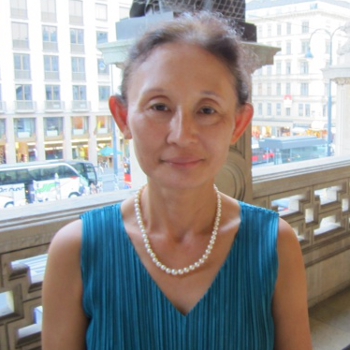Rusalka is a fairy-tale opera about a water nymph who falls in love with a Prince and wishes to transform herself into a human being to experience love. She sacrifices her voice for a witch’s spell, but is rejected by the Prince after a brief infatuation and both pay the ultimate price. The story’s dark undertone of deceit, cruelty and betrayal has been explored in a number of provocative recent productions in Europe. The Met’s new production, directed by Mary Zimmerman, places the action in the 18th century. It has some stunning visual images and colors. It does not, however, go very far in venturing beneath the surface. Other than the Act 2 dance scene with its hints of sexual indulgences and exploitations, the production is content to present the fairy tale in a straightforward manner with little hint of subtext.
Daniel Ostling's sets place the action in a series of tree-painted boxy frames in Act 1, with a large tree center-stage. The lake is an opening on the floor. As Rusalka sings her “Song to the Moon”, a large shining moon ascends. The Water Goblin has the unenviable task of singing with the bottom half of his body under the cutout lake and of having to maneuver the “lillies” flung about by wood sprites. Rusalka wears a long flowing dress decorated with water lilies that hamper movement. When the witch Ježibaba appears with her three “helpers (a mouse, a cat, and a crow)” to grant Rusalka’s wish, the stage turns darker with a backdrop of brown forests, together with a medicine cabinet and examination table. The dark forest turns into a bright daylight as the backdrop rises to reveal Rusalka’s tree far in the distance, with a blue sky and yellow flowers. The romance between the Prince and Rusalka unfolds in a pretty but glaring setting.
Act 2 opens to reveal a hallway in the Prince’s castle, with servants preparing for the wedding as the gamekeeper and kitchen boy fill in the palace gossip. The green wallpaper backdrop rises to reveal a room painted in red, with black tree patterns. The Foreign Princess and the guests are dressed in bright red, orange and yellow, as Rusalka’s pale gown indicates her otherworldliness. The lighting changes to menacing, dark and green with the water gnome’s appearance. TJ Gerckens’ lighting work is stunning and effective throughout.
During the Act 3 prelude, a disheveled and forlorn Rusalka appears in front of the curtain (painted trees on the lake). The curtain rises to reveal the forest of Act 1 in a state of disarray in dim lighting. The director’s intention appears to indicate the corruption of nature (Rusalka) by humans. The Water Goblin and water sprites have no physical presence in this forest, and are only heard as voices off stage. The contrite Prince rushes in for a final encounter with Rusalka, whose kiss kills him to cleanse the human sins. Rusalka walks away alone, wearing the Prince’s coat, symbolizing her fate of being neither part of nature nor of the human world.
Zimmerman’s directing is confined to general blocking with the singers left to work out the finer details. Kristine Opolais, whose international career was launched with Rusalka in Munich in 2010, was a consummate water nymph, with her cool soprano rising to the role’s climactic high notes with moving radiance. Her voice is not rich in color, but that suited her characterization of Rusalka as a creature at odds with both the natural and human worlds. Brandon Jovanovich met the challenge of the role of Prince which requires both heroic heft and ringing tone as well as soft and lyrical tenderness. His voice opened up warmly and easily above the staff, and he acted as a well meaning but callow man used to having his way.
Jamie Barton was a vocal standout as Ježibaba, her rich and deep chest voice a special and memorable treat. Eric Owens used his grave but flexible voice to portray a sympathetic father figure when he was not hampered by awkward staging, and was best in Act 2. Katarina Dalayman sang with fiery passion as the Foreign Princess. Singing from the pit, Anthony Clark Evans’ hunter was exceptional in the clarity and beauty of tone. The three wood sprites sang and danced in charming unison, with Hyesang Park leading with her melting soprano.
Sir Mark Elder chose a slow tempo, especially for the Act 1 prelude, but brought out the textual complexity of the score, with emphasis on transparency. He turned up the volume in the Act 2 ball scene, with the Met Orchestra’s brass section responding in thrilling manner. Strings were exquisite, subtle and beautiful. The final duet of Rusalka and the Prince was a culmination of the hours of slow but steady build up of beautiful melodies combined with Czech folk elements, a most satisfying and moving conclusion.




